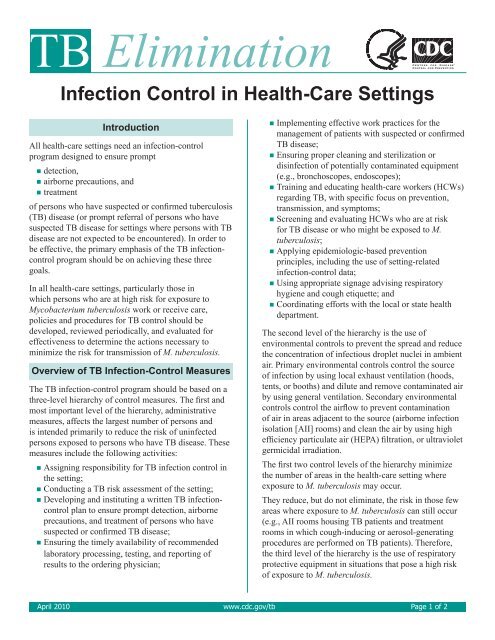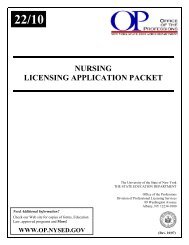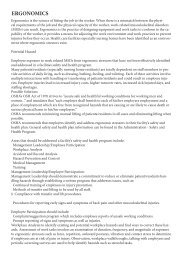TB Infection Control - Healthsource Global!
TB Infection Control - Healthsource Global!
TB Infection Control - Healthsource Global!
Create successful ePaper yourself
Turn your PDF publications into a flip-book with our unique Google optimized e-Paper software.
<strong>TB</strong> Elimination<br />
<strong>Infection</strong> <strong>Control</strong> in Health-Care Settings<br />
Introduction<br />
All health-care settings need an infection-control<br />
program designed to ensure prompt<br />
• detection,<br />
• airborne precautions, and<br />
• treatment<br />
of persons who have suspected or confirmed tuberculosis<br />
(<strong>TB</strong>) disease (or prompt referral of persons who have<br />
suspected <strong>TB</strong> disease for settings where persons with <strong>TB</strong><br />
disease are not expected to be encountered). In order to<br />
be effective, the primary emphasis of the <strong>TB</strong> infectioncontrol<br />
program should be on achieving these three<br />
goals.<br />
In all health-care settings, particularly those in<br />
which persons who are at high risk for exposure to<br />
Mycobacterium tuberculosis work or receive care,<br />
policies and procedures for <strong>TB</strong> control should be<br />
developed, reviewed periodically, and evaluated for<br />
effectiveness to determine the actions necessary to<br />
minimize the risk for transmission of M. tuberculosis.<br />
Overview of <strong>TB</strong> <strong>Infection</strong>-<strong>Control</strong> Measures<br />
The <strong>TB</strong> infection-control program should be based on a<br />
three-level hierarchy of control measures. The first and<br />
most important level of the hierarchy, administrative<br />
measures, affects the largest number of persons and<br />
is intended primarily to reduce the risk of uninfected<br />
persons exposed to persons who have <strong>TB</strong> disease. These<br />
measures include the following activities:<br />
• Assigning responsibility for <strong>TB</strong> infection control in<br />
the setting;<br />
• Conducting a <strong>TB</strong> risk assessment of the setting;<br />
• Developing and instituting a written <strong>TB</strong> infectioncontrol<br />
plan to ensure prompt detection, airborne<br />
precautions, and treatment of persons who have<br />
suspected or confirmed <strong>TB</strong> disease;<br />
• Ensuring the timely availability of recommended<br />
laboratory processing, testing, and reporting of<br />
results to the ordering physician;<br />
• Implementing effective work practices for the<br />
management of patients with suspected or confirmed<br />
<strong>TB</strong> disease;<br />
• Ensuring proper cleaning and sterilization or<br />
disinfection of potentially contaminated equipment<br />
(e.g., bronchoscopes, endoscopes);<br />
• Training and educating health-care workers (HCWs)<br />
regarding <strong>TB</strong>, with specific focus on prevention,<br />
transmission, and symptoms;<br />
• Screening and evaluating HCWs who are at risk<br />
for <strong>TB</strong> disease or who might be exposed to M.<br />
tuberculosis;<br />
• Applying epidemiologic-based prevention<br />
principles, including the use of setting-related<br />
infection-control data;<br />
• Using appropriate signage advising respiratory<br />
hygiene and cough etiquette; and<br />
• Coordinating efforts with the local or state health<br />
department.<br />
The second level of the hierarchy is the use of<br />
environmental controls to prevent the spread and reduce<br />
the concentration of infectious droplet nuclei in ambient<br />
air. Primary environmental controls control the source<br />
of infection by using local exhaust ventilation (hoods,<br />
tents, or booths) and dilute and remove contaminated air<br />
by using general ventilation. Secondary environmental<br />
controls control the airflow to prevent contamination<br />
of air in areas adjacent to the source (airborne infection<br />
isolation [AII] rooms) and clean the air by using high<br />
efficiency particulate air (HEPA) filtration, or ultraviolet<br />
germicidal irradiation.<br />
The first two control levels of the hierarchy minimize<br />
the number of areas in the health-care setting where<br />
exposure to M. tuberculosis may occur.<br />
They reduce, but do not eliminate, the risk in those few<br />
areas where exposure to M. tuberculosis can still occur<br />
(e.g., AII rooms housing <strong>TB</strong> patients and treatment<br />
rooms in which cough-inducing or aerosol-generating<br />
procedures are performed on <strong>TB</strong> patients). Therefore,<br />
the third level of the hierarchy is the use of respiratory<br />
protective equipment in situations that pose a high risk<br />
of exposure to M. tuberculosis.<br />
April 2010 www.cdc.gov/tb Page 1 of 2
Use of respiratory protection equipment can further<br />
reduce risk for exposure of HCWs to infectious droplet<br />
nuclei that have been expelled into the air from a patient<br />
with infectious <strong>TB</strong> disease. The following measures can<br />
be taken to reduce the risk for exposure:<br />
• Implementing a respiratory protection program<br />
• Training HCWs on respiratory protection<br />
• Training patients on respiratory hygiene and cough<br />
etiquette procedures.<br />
Determining the Infectiousness<br />
of <strong>TB</strong> Patients<br />
In general, patients who have suspected or confirmed<br />
<strong>TB</strong> disease should be considered infectious if (a) they<br />
are coughing, undergoing cough-inducing procedures,<br />
or have positive sputum smear results for acid-fast<br />
bacilli (AFB); and (b) they are not receiving adequate<br />
antituberculosis therapy, have just started therapy, or<br />
have a poor clinical or bacteriologic response to therapy.<br />
For patients placed under airborne precautions because<br />
of suspected infectious <strong>TB</strong> disease of the lungs, airway,<br />
or larynx, airborne precautions can be discontinued when<br />
infectious <strong>TB</strong> disease is considered unlikely and either<br />
• Another diagnosis is made that explains the clinical<br />
syndrome, or<br />
• The patient produces three consecutive negative<br />
sputum smears collected in 8- to 24-hour intervals<br />
(one should be an early morning specimen).<br />
Patients for whom the suspicion of infectious <strong>TB</strong> disease<br />
remains after the collection of three negative sputum<br />
smear results should not be released from airborne<br />
precautions until they<br />
• Receive standard multidrug antituberculosis<br />
treatment (minimum of 2 weeks) and<br />
• Demonstrate clinical improvement.<br />
For these patients, additional diagnostic approaches<br />
(e.g., sputum induction) and, after sufficient time on<br />
treatment, bronchoscopy may need to be considered.<br />
Patients who have drug-susceptible <strong>TB</strong> of the lung,<br />
airway, or larynx, should remain under airborne<br />
precautions until they<br />
• Produce three consecutive negative sputum smears<br />
collected in 8- to 24-hour intervals (one should be an<br />
early morning specimen), and<br />
• Receive standard multidrug antituberculosis<br />
treatment (minimum of 2 weeks), and<br />
• Demonstrate clinical improvement.<br />
Note<br />
The Centers for Disease <strong>Control</strong> and Prevention (CDC)<br />
is not a regulatory agency; CDC recommendations on<br />
infection control provide evidence-based guidance.<br />
For regulations in your area, refer to state and local<br />
regulations and contact your local Occupational Safety<br />
and Health Administration (OSHA) office. A directory of<br />
OSHA offices may be found at www.osha-slc.gov/html/<br />
RAmap.html.<br />
References<br />
CDC. Guidelines for preventing the transmission of<br />
Mycobacterium tuberculosis in health-care settings,<br />
2005. MMWR 2005; 54(No. RR-17).<br />
www.cdc.gov/mmwr/pdf/rr/rr5417.pdf<br />
Additional Information<br />
Websites:<br />
CDC Division of Tuberculosis Elimination:<br />
www.cdc.gov/tb<br />
State <strong>TB</strong> control offices:<br />
www.cdc.gov/tb/links/tboffices.htm<br />
National Institute for Occupational Safety and Health:<br />
www.cdc.gov/niosh/topics/tb<br />
Occupational Safety and Health Administration:<br />
www.osha.gov/SLTC/tuberculosis/<br />
Fact Sheet:<br />
Respiratory Protection in Health-Care Settings:<br />
www.cdc.gov/tb/publications/factsheets/prevention/<br />
rphcs.htm<br />
April 2010 www.cdc.gov/tb Page 2 of 2<br />
Safer . Healthier . People
<strong>TB</strong> Elimination<br />
Respiratory Protection in Health-Care Settings<br />
Introduction<br />
All health-care settings need an infection-control<br />
program designed to ensure prompt<br />
• detection,<br />
• airborne precautions, and<br />
• treatment<br />
of persons who have suspected or confirmed<br />
tuberculosis (<strong>TB</strong>) disease. There are three levels<br />
of <strong>TB</strong> infection control in health-care settings.<br />
The first level of the infection-control hierarchy,<br />
administrative controls, should minimize the<br />
number of areas where exposure to Mycobacterium<br />
tuberculosis may occur.<br />
The second level, environmental controls,<br />
should reduce the concentration of airborne<br />
M. tuberculosis. These administrative and<br />
environmental controls should also reduce, although<br />
they do not eliminate, the risk in the few areas<br />
where exposures can still occur (e.g., airborne<br />
infection isolation [AII] rooms and rooms where<br />
cough-inducing or aerosol-generating procedures<br />
are performed).<br />
Because persons entering these areas may be<br />
exposed to airborne M. tuberculosis, the third level<br />
of the hierarchy is the use of respiratory protective<br />
equipment in situations that pose a high risk for<br />
exposure.<br />
Considerations for Selection of Respirators<br />
The overall effectiveness of respiratory protection<br />
is affected by 1) the level of respiratory protection<br />
selected (e.g., the assigned protection factor), 2) the<br />
fit characteristics of the respirator model, 3) the care<br />
in using the respirator, and 4) the adequacy of the<br />
training and fit-testing program.<br />
Particulate filter respirators certified by the Centers<br />
for Disease <strong>Control</strong> and Prevention’s (CDC)<br />
National Institute for Occupational Safety and<br />
Health (NIOSH) that can be used for protection<br />
against airborne M. tuberculosis include<br />
• Nonpowered respirators with N95, N99,<br />
N100, R95, R99, R100, P95, P99, and P100<br />
filters (including disposable respirators); and<br />
• Powered air-purifying respirators (PAPRs)<br />
with high-efficiency filters.<br />
The most essential attribute of a respirator is<br />
the ability to fit the varying facial sizes and<br />
characteristics of health-care workers (HCWs).<br />
Assistance with selection of respirators can be<br />
done by referring to peer-reviewed research and<br />
through consultation with respirator fit-testing<br />
experts, CDC, occupational health and infectioncontrol<br />
professional organizations, respirator<br />
manufacturers, and from participation in advanced<br />
respirator training courses.<br />
Implementing a Respiratory<br />
Protection Program<br />
If respirators are used in a health-care setting, the<br />
Occupational Safety and Health Administration<br />
(OSHA) requires the development, implementation,<br />
administration, and periodic reevaluation of a<br />
respiratory protection program. The most critical<br />
elements of a respiratory protection program<br />
include 1) assignment of responsibility, 2) training,<br />
and 3) fit testing. All HCWs who use respirators for<br />
protection against M. tuberculosis infection should<br />
be included in the respiratory protection program.<br />
The health-care setting should develop a policy<br />
on the use of respirators by visitors. Visitors to<br />
AII rooms and other areas with patients who have<br />
suspected or confirmed infectious <strong>TB</strong> disease<br />
may be offered respirators (e.g., N95 disposable<br />
respirators) and should be instructed by an HCW<br />
on the use of the respirator before entering an AII<br />
room.<br />
April 2010 www.cdc.gov/tb Page 1 of 2
To be effective and reliable, respiratory protection<br />
programs must include at least the following<br />
elements:<br />
• Assignment of responsibility to one person<br />
with sufficient knowledge who is given the<br />
authority and responsibility to manage all<br />
aspects of the program.<br />
• Standard operating procedures that include<br />
information and guidance for the proper<br />
selection, use, and care of respirators.<br />
• Screening by a physician or other licensed<br />
health-care professional of all HCWs who<br />
might need to use a respirator for pertinent<br />
medical conditions at the time they are<br />
hired, and then re-screening periodically.<br />
• Annual training of HCWs with specific<br />
focus on prevention, transmission, and<br />
symptoms.<br />
• Selection of filtering facepiece respirators<br />
approved by CDC/NIOSH.<br />
• Fit testing performed during the initial<br />
respiratory protection program training and<br />
periodically thereafter, in accordance with<br />
federal, state, and local regulations.<br />
• Inspection and maintenance of respirators<br />
according to manufacturer instructions.<br />
• Evaluation of the respirator program<br />
periodically to ensure its continued<br />
effectiveness.<br />
Information on the development and management<br />
of a respiratory protection program is available<br />
in technical training courses that cover the<br />
basics of respiratory protection. Such courses<br />
are offered by OSHA, the American Industrial<br />
Hygiene Association, the American Conference of<br />
Governmental Industrial Hygienists, universities,<br />
manufacturers, and private contractors.<br />
Note<br />
The Centers for Disease <strong>Control</strong> and Prevention<br />
(CDC) is not a regulatory agency; CDC<br />
recommendations on infection control provide<br />
evidence-based guidance. For regulations in<br />
your area, refer to state and local regulations and<br />
contact your local Occupational Safety and Health<br />
Administration (OSHA) office. A directory of<br />
OSHA offices may be found at www.osha-slc.gov/<br />
html/RAmap.html.<br />
References<br />
CDC. Guidelines for preventing the transmission of<br />
Mycobacterium tuberculosis in health-care settings,<br />
2005. MMWR 2005; 54(No. RR-17).<br />
www.cdc.gov/mmwr/pdf/rr/rr5417.pdf<br />
Occupational Safety and Health Administration.<br />
Occupational safety and health standards, subpart<br />
I—personal protective equipment. Respiratory<br />
protection. Title 29, Code of Federal Regulations<br />
2003. Section 1910.134.<br />
www.osha.gov/pls/oshaweb/owadisp.show_<br />
document?p_table=STANDARDS&p_id=12716<br />
Additional Resources<br />
Websites:<br />
CDC Division of Tuberculosis Elimination:<br />
www.cdc.gov/tb<br />
CDC National Institute for Occupational Safety and<br />
Health: www.cdc.gov/niosh/topics/tb<br />
Occupational Safety and Health Administration:<br />
www.osha-slc.gov/SLTC/tuberculosis/index.html<br />
State <strong>TB</strong> control offices:<br />
www.cdc.gov/tb/links/tboffices.htm<br />
American Industrial Hygiene Association:<br />
www.aiha.org<br />
April 2010 www.cdc.gov/tb Page 2 of 2<br />
Safer . Healthier . People<br />
American Conference of Governmental Industrial<br />
Hygienists: www.acgih.org<br />
Fact Sheet:<br />
<strong>Infection</strong> <strong>Control</strong> in Health-Care Settings:<br />
www.cdc.gov/tb/publications/factsheets/prevention/<br />
ichcs.htm
<strong>TB</strong> INFECTION CONTROL<br />
<strong>TB</strong> <strong>Infection</strong> <strong>Control</strong><br />
I understand and agree to comply with all safety standards set forth by my employer,<br />
HealthSource <strong>Global</strong> Staffing.<br />
I certify by my signature below, that I have been provided with the HealthSource <strong>Global</strong><br />
Staffing <strong>TB</strong> <strong>Infection</strong> <strong>Control</strong> advisory.<br />
___________________________________<br />
_______








